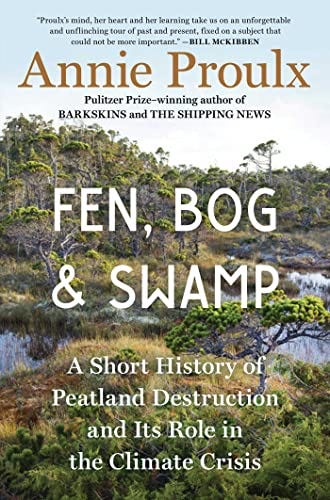Fen, Bog & Swamp: A short History of Peatland Destruction and Its Role in the Climate Crisis
A book review
Fen, Bog & Swamp: A short History of Peatland Destruction and Its Role in the Climate Crisis
Annie Proulx
Scribner 2022
208 pages
Concerned about the state of our wildlands, novelist Annie Proulx has given us Fen, Bog & Swamp. The book is a heartbreaking narrative of our drainage and destruction of these wetlands, and another voice in the chorus of commentary reminding us that we are crazily heating our planet.
Proulx starts her book with the wonder and surprises she experienced when her mother took her, as a young child, to a swamp, a journey that turned Proulx into a lifelong nature lover. This reminiscence serves as a springboard for the author’s musings that combine memoir, history, geography, and the science of climate change. The narrative wanders from the slopes of Kilimanjaro, where the Chagga people farm bananas, to the author’s time living in the Pacific Northwest. Proulx’s narrative skills deftly tie these threads together to such a degree that, despite the reminders of our great destruction of the natural world, the book is immensely pleasurable to read.
Thereafter this short book consists of three chapters, each individually devoted to bogs, English fens, and swamps. Throughout, the immensity of peatland loss is difficult to imagine. By the 1980s, the United States had wiped out half of its wetlands, with some states completely destroying them. From 2004 to 2009, a span of only five years, the U.S. turned an additional 62,300 wetland acres into agriculture and housing developments. In the 1980s, wanting land to grow trees, Great Britain destroyed 190,000 hectares of bogs in Scotland.
As if the loss of nature, biodiversity, and beauty weren’t enough, the destruction of swamps, bogs, and fens is a major contributor to climate change. Acre for acre, these peatlands perform an outsized service of carbon sequestration. As Proulx explains, when twigs, leaves, and other organic detritus decompose on forest floors or in grassland, they return to the biosphere. If the same material falls into a peatland, the acidic (bog) or alkaline (fen) waters disrupt decomposition. The organic material remains in the peatland, effectively removed and sequestered from the biosphere. Fewer and smaller peatlands ultimately mean more CO2 warming the planet.
Proulx prepared herself well for this project. She recounts the story of wetlands formation, starting with the receding glaciers at the end of the last Ice Age. From the Roman Empire to today, she covers a great swath of human history. She also shares a bit of biology as she describes the mosses, insects, trees, and animals that make their homes in the damp environments of the world.
Although Proulx expertly conveys the tragic loss of our wetlands, there are some problems with the book. First, the book is well-referenced, but not footnoted, and the notes at the end are labrynthine. Text is referenced by page only in the notes, followed by the source information. Without citation numbers or symbols, I found the references difficult to navigate, which slowed my reading.
Moreover, some interesting paragraphs and pages concerning the history or science of the wetlands lack references altogether. There are also references in the notes section that don’t correspond to any text on their referenced pages.
I found more than a few non sequiturs. A paragraph on sea level rise might veer for a sentence or two to the size of Neolithic settlements. Several pages may go by as Proulx recounts the history of the Roman Empire, with no apparent connection to peatlands or climate change.
Proulx is a masterful narrator, and her novels and short stories have captured the attention of millions of readers. And yet I felt that much of the subject matter of this book was being kept at arm’s length. There is little vibrancy that one might experience actually being in or near these landscapes that skirt between land and water, few comments or details of the buzz of bees, chirping of birds, or aroma of wildflowers.
The book lacks people, too. We don’t hear the voices of conservationists and nature enthusiasts who dedicate their lives to protecting our fens, bogs, and swamps. There are few direct quotes to enliven the pages. Proulx confesses in her Acknowledgements that the book was written during the pandemic, which restricted her travels. Has she heard of Zoom?
For the casual reader, this book may serve as a starting point to learn about peatlands, although if I were to suggest a book for general interest, I would pick Swamplands by Ed Struzik. His book covers more ground, more history, and more biology.
Business:
As a subscriber or occasional reader of The Green Dispatch, you may already know that a portion of the profits from this Substack goes to support the organizations working to preserve the world’s wildlands. While the overall profits for The Green Dispatch are embarrassingly small (under $1,000 in 2022), we were able to contribute a total of about $100 to the Center for Biological Diversity and Fauna & Flora International.
While I do not intensively investigate the organizations, I try to ensure that these are environmental organizations that have not been influenced or bought off by corporate interests nor subjected to corporate greenwashing. Those kinds of organizations are not getting money from The Green Dispatch.
If you want to see a larger sum contributed next year, please make sure to share The Green Dispatch on social media. The more this publication is shared, the more subscribers sign up. And that means more wildlands are saved.




